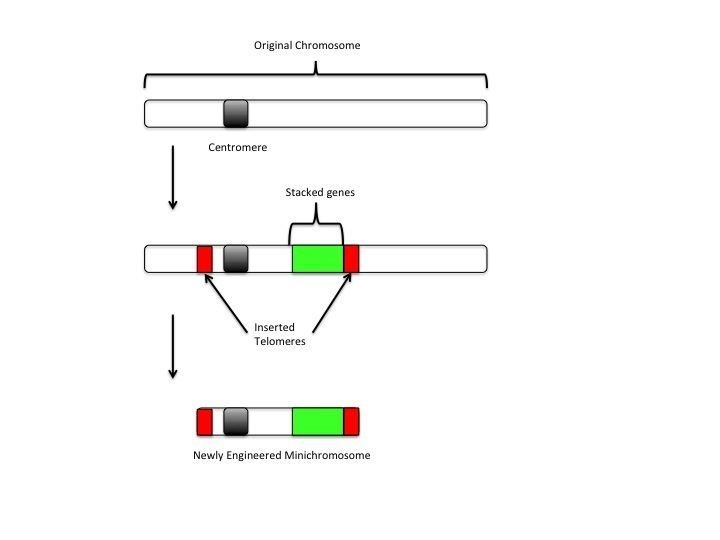 | ||
Overview
A minichromosome is a small chromatin-like structure consisting of centromeres, telomeres and replication origins and little additional genetic material. They replicate autonomously in the cell during cellular division. The origin of minichromosomes is the result of natural processes (chromosomal aberrations) or genetic engineering.
Contents
- Overview
- Structure
- Production
- De novo
- Top down
- Role in Genetic Engineering
- Plants
- Other Organisms
- References
Structure
Minichromosomes can be either linear or circular pieces of DNA. By minimizing the amount of unnecessary genetic information on the chromosome and including the basic components necessary for replication (centromere, telomeres, replication sequence), scientists aim to construct a chromosomal platform which can be utilized to insert/present new genes into a host organism's cell.
Production
Producing minichromosomes involves two primary methods, the de novo (bottom-up) and the top-down approach.
De novo
The minimum constituent parts of a chromosome (centromere, telomere and DNA replication sequences) are assembled This is done by using molecular cloning techniques to construct the desired chromosomal contents in vitro. Next, the desired contents of the minichromosome must be transformed into a host which is capable of assembling the components (typically yeast or mammalian cells) into a functional chromosome. This approach has been attempted for the introduction of minichromosomes into maize for the possibility of genetic engineering, but the success was limited and questionable. In general, the de novo approach is more difficult than a top down method due to species incompatibility issues and the heterochromatic nature of centromeric regions.
Top-down
This method utilizes the mechanism of telomere-mediated chromosomal truncation (TMCT). This process is the generation of truncation by selective transformation of telomeric sequences into a host genome. This insertion causes the generation of more telomeric sequences and eventual truncation. The newly synthesized truncated chromosome can then be altered through the insertion of new genes for desired traits. The top-down approach is generally considered as the more plausible means of generating extra-numary chromosomes for the use of genetic engineering of plants. In particular it is useful because their stability during cell division has been demonstrated. The limitation of this approach is that it is labor-intensive.
Role in Genetic Engineering
Unlike traditional methods of genetic engineering, minichromosomes can be used to transfer and express multiple sets of genes onto one engineered chromosome package Traditional methods which involve the insertion of novel genes into existing sequences may result in the disruption of endogenous genes and thus negatively affect the host cell. Additionally, with traditional gene insertion methods, scientists have had less ability to control where the newly inserted genes are located on the host cell chromosomes which makes it difficult to predict inheritance of multiple genes from generation to generation. Minichromosome technology allows for the stacking of genes side-by-side on the same chromosome thus reducing likelihood of segregation of novel traits.
Plants
In 2006, scientists demonstrated the successful use of telomere truncation in maize plants to produce minichromosomes that could be utilized as a platform for inserting genes into the plant genome. In plants, the telomere sequence is conserved which implies this strategy can be utilized to successfully construction additional minichromosomes in other plant species.
In 2007, scientists reported success in assembling minichromosomes in vitro using the de novo method.
The use of minichromosomes as a means for generating more desirable crop traits is actively being explored. Major advantages include the ability to introduce genetic information which is highly compatible with the host genome. This eliminates the risk of disrupting various important processes such as cell division and gene expression. With continued development, the future for use of minichromosomes may make a huge impact on the productivity of major crops.
Other Organisms
Minichromosomes have been reported in yeast and animal cells. These minichromosomes were constructed using the De novo approach.
